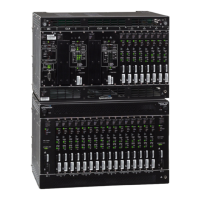124 TimeHub 5500 User’s Guide 097-55501-01 Revision M – January 2009
Chapter 3 Installing the TimeHub 5500
Making Signal Connections
the alarm on the AUD pins and the cutoff LED will light (indicating that audible
alarms have been cut off). Any alarm asserted on the VIS wire-wrap pins is
unaffected by the cutoff pushbutton. The alarm LED and cutoff LED will remain lit
until the condition causing the alarm is no longer present. Should new alarms occur
later, the AUD alarm will activate again.
Connecting Office Alarms
The Office alarms provide normally-open, center, and normally-closed contact pins.
You connect the office alarms to the OFFICE ALARM critical (CR), major (MJ), and
minor (MN) wire-wrap pins on the Input/Alarm Connector module. See Figure 3-18
for the location of the pins.
Use the AUD pins on the left for audible alarms and the VIS pins on the right for
visible alarms. Connect the alarm circuit between the NO and C pins for normally
open contacts, or between the NC and C pins for normally closed contacts. If
required, use the pins (VIS) on the right to connect to remote telemetry equipment.
Perform the following steps to ensure proper alarm connections to the TimeHub
5500.
1. Ensure that both fuses are removed from the front panel.
2. Locate the OFFICE ALARM critical (CR), major (MJ), and minor (MN) wire-wrap
pins on the Input/Alarm Connector module.
3. Connect office alarms to the wire-wrap terminals.
4. Verify that correct wiring connections have been made.
5. Reinstall both fuses.
Note: If simultaneously-occurring alarms have different severity
levels, only the alarm with the highest severity appears on the front
panel LEDs if the alarms are both either in the “System” or “Shelf”
category. For example, if there are both MAJOR and MINOR shelf
alarms present, only the MAJOR alarm LED is lit in the “Shelf” alarm
row. In this case, if the MAJOR alarm ends, then the MINOR alarm
LED will light (assuming that the source of that alarm is still present)
since this is now the highest severity alarm.
It is possible to have alarm LEDs of different severity illuminated if
one is a shelf alarm and the other a system alarm. If there is a
MAJOR shelf alarm and a MINOR system alarm (any of the external
alarms in 7 to 10 range), then the MAJOR LED is lit for the shelf alarm
row and the MINOR LED is lit for the system alarm row.
Note: In an alarm condition or loss of DC power, the contact between
the NO and COM closes and the contact between the NC and COM
opens.

